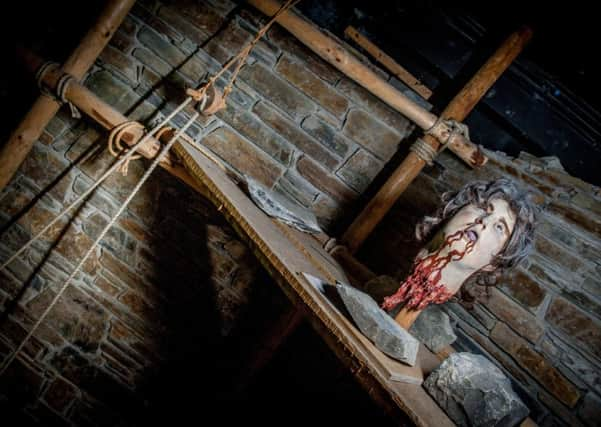Severed head depicts plotpivotal to building of Walls


This gruesome feature in the exhibition depicts the discovery of the Great Northern Plot of 1615 and the subsequent trial and execution of the alleged conspirators in Derry at the end of July of that year.
The plot had an immediate effect in Derry forcing the City of London’s Irish Society to start in earnest to finish the building of the Derry Walls.
Advertisement
Hide AdAdvertisement
Hide AdSome debate remains amongst academics about whether the conspiracy was real or just ‘a little overzealous talk over a few drinks in Nicholas Gill’s Macosquin alehouse’.
The plot was hatched in May 1614 and was intended to take place in August 1615, when the towns of Londonderry, Coleraine, Lifford, Culmore and Limavady plus the Irish Society agents and Sir Thomas Philips, were to be seized.
The chief conspirators were Rory O’Cahan, aggrieved that Phillips was residing in his father’s castle in Limavady; Alexander MacDonnell, nephew of Sir Randal MacDonnell, later Earl of Antrim; two brothers of Sir Niall Garbh O’Donnell of Donegal; and Brian Crossagh O’Neill, nephew of the exiled Earl of Tyrone and freeholder in the Kildress area of Tyrone.
For Sir Arthur Chichester, Lord Deputy of Ireland, the conspiracy provided the excuse he needed to force a troublesome Irish Parliament, made up of Old English, Catholic Irish and New English Settlers to accept a taxation bill before it was dissolved.
Advertisement
Hide AdAdvertisement
Hide AdA local plot in a north-west alehouse may have been hyped up as a convenient national security crisis. James I fresh from his experience of the Gunpowder Plot of 1604 was alarmed by the news of the conspiracy and his Privy Council congratulated Chichester for his vigilance and reprimanded the Irish Society for their tardiness in completing the defences at Derry.
The conspiracy was certainly taken seriously by the Dublin authorities. Chichester sanctioned the use of judicial torture to extract information from one of the conspirators. Cuconnacht O’Keenan perhaps has the dubious distinction of being the first man ‘racked’ in Ireland.
Two judges and the Mayor of Derry tried the case at the end of July 1615.
The jury of 15 men included settlers such as Henry Vaughan, a solider who had settled at Kilmacrennan after the Nine Years War; Anthony Lipsett a carpenter who had come to work for the Londoners in the building of houses in Derry; and two of Rory O’Cahan’s uncles!
Advertisement
Hide AdAdvertisement
Hide AdOf the chief conspirators, Alexander MacDonnell was declared not guilty. Rory O’Cahan, Brian Crossagh O’Neill and four others were found guilty and sentenced to death.
As was mandatory in such cases, they were likely to have been drawn through the streets of Londonderry in chains to the gallows where they would have been hanged. When only half dead, they would have been cut down, disembowelled, beheaded, their bodies quartered and then burnt. Their heads would have been displayed above the city gates as a deterrent to others.
Professor Raymond Gillespie of Maynooth University, in his 1987 book on the plot, concludes: “The conspirators appear to have been more a collection of aggrieved men with very diverse types of grievances, bound together by social and religious forces, than instigators of a carefully laid plot masterminded by the exiled Earl of Tyrone to stage a return and overthrow the new order.”
Whatever the truth is about its scale, the story of the Great Northern Plot of 1615 is very much part of the history of the building of the Derry Walls.